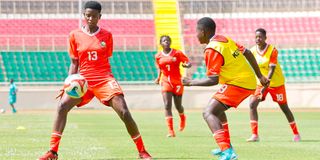The dark side of women's sporting success: a widening 'gender play gap'

Harambee Starlets under-17 team train on March 15, 2025 at Nyayo National Stadium, ahead of their 2025 Fifa U-17 Women’s World Cup qualifier against Uganda. A new research reveals why young women abandon sport and how we can bring them back.
What you need to know:
- Despite elite-level successes in women's sports, a significant "gender play gap" persists with fewer women and girls participating in community sports compared to men and boys.
- Research identifies four key reasons young women drop out.
- Closing this gap requires targeted re-engagement programs.
Women’s sport has recently enjoyed unprecedented success in Australia.
We have seen the Matildas sell out 16 successive home games, a world-record attendance for a women’s Test cricket match at the Melbourne Cricket Ground (MCG), and women athletes contribute 72 per cent of Australia’s gold medal tally at the Paris Olympics.
However, against the backdrop of these successes, women and girls continue to participate in community sport at lower rates than boys and men, a phenomenon known as the “gender play gap”.
What is the ‘gender play gap’?
The gender play gap is the difference between the number of women and girls participating in sport compared to the number of men and boys.
The gap exists from a very young age, with Australian government data showing nearly 30 per cent more boys aged 0–14 participate in club or association sport than girls.
The gap closes to just 2 per cent between the ages of 15–17, but then explodes to 43% for those aged 18–24.
Although the gap grows and shrinks at various points, it is consistently in favour of more men and boys participating in organised sport than women and girls.
Trying to find answers
Together with colleagues at Flinders University, we are currently working with the South Australian government to research how to close this gap.
The first stage found there isn’t enough research attention to this area. Of the 3,000+ studies included in a global literature search, only five focused on increasing rates of sport participation in young women.
We then conducted a large-scale qualitative study which uncovered the following reasons why young women drop out of sport, and often do not re-engage.
Sport stops being fun
Social experiences in sport are central to girls’ enjoyment and long-term participation. While friendships keep them engaged, negative team dynamics, exclusion and club politics can push them away.
A lack of genuine equality
Although progress in gender equality has been made, young women still struggle to have the same access to facilities and quality coaching as males. Typically, women and girls prefer women coaches who can relate to their experiences, yet women remain underrepresented in these roles.
They have too much on their plates
Schoolwork, part-time jobs and social lives compete for young women’s time, and many feel overwhelmed by increasing training commitments and school demands. In addition, girls as young as 13 are promoted to senior-age teams, which adds pressure and can break the social bonds with their peers.
They lose competitive opportunities
Although some young women enjoy a more relaxed, social approach to sport, others really value structured training and competition. Many girls end up dropping out because the competitive opportunities for them are not of the same standard as those available to boys. Some sports have fewer games per season for girls, or a shorter finals series than for boys.
How can we close the gap?
Sport participation efforts have typically focused on recruitment of new participants and retention of existing participants.
With so many young women dropping out of sport during adolescence, a renewed focus on re-engaging these previous participants may help to close the gender play gap.
Dropout is often considered a failure and a negative endpoint of a sport participation journey. However, there is a growing sentiment in sport research that transitioning out of sport temporarily may be necessary for some adolescents’ development.
It is okay for anyone to take a break from sport, but the sport needs to make it easier for them to return when they are ready. The key is to make re-engagement easy and appealing.
Re-engagement programs should be distinctly different from those aimed at new participants, and should revolve around the following key areas:
Targeted promotion and communication
Often, young women do not return to sport because they’re not aware of available opportunities if they return. Sport organisations should highlight programs that cater to those who want to start playing again, as well as those aimed at new participants.
Strengthen social connection
Young women are more likely to return to sport if they feel a sense of belonging and connection and have opportunities to create friendships outside of school. Programs that can foster strong social bonds while maintaining a focus on competition and skill development are most likely to be effective.
Champion equity and inclusion
Gender equity must be a priority for all sport organisations, with all genders having equitable access to high-quality training and competition.
Future-proofing
To achieve long-term gender equality in sport, organisations must actively future-proof their programs by encouraging women’s and girl’s leadership and providing young women with same-gender role models. By embedding gender equity into policies, coaching pathways and community engagement, sport organisations can create a more sustainable and welcoming environment for young women.
What’s next?
Despite the success of women’s sport in recent years, we have a long way to go to achieve genuine gender equality in sport.
Rather than relying on one-size-fits-all approaches to participation, sport organisations should adopt a targeted approach that may narrow the gender play gap and progress towards a more equitable sport participation landscape.
James Kay is a PhD candidate at the College of Education, Psychology and Social Work, Flinders University while Sam Elliott is an Associate Prof and Researcher, SHAPE Research Centre, Flinders University.


